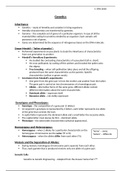Summary
Summary Grade 12 Genetic Engineering - Life Science IEB
These notes have been made using The Answer Series Part I and II. The notes have been made for the use of IEB students. These notes include all that is needed for IEB Finals in Life Science - HOWEVER, these notes should not be used in isolation but rather in conjunction with various other sources a...
[Show more]
Preview 2 out of 11 pages
Uploaded on
August 7, 2020
Number of pages
11
Written in
2018/2019
Type
Summary
By: marinaprando • 1 year ago
By: glendapaterson5 • 2 year ago
By: soniaford11 • 1 year ago
By: aimeeroux14 • 3 year ago
By: info3910 • 4 year ago
R80,00
Also available in package deal from R260,00
100% satisfaction guarantee
Immediately available after payment
Both online and in PDF
No strings attached
Document also available in package deal (1)
R 510,00
R 260,00
6 items
1. Summary - All evolution notes - life science ieb grade 12
2. Summary - Grade 12 human reproduction - life science ieb
3. Summary - Grade 12 genetic engineering - life science ieb
4. Summary - Grade 12 human endocrine system - life science ieb
5. Summary - Grade 12 reproduction in plants - life science ieb
6. Summary - Grade 12 reproductive strategies - life science ieb
Show more
JFIN 2018JFIN JFIN 20182018




